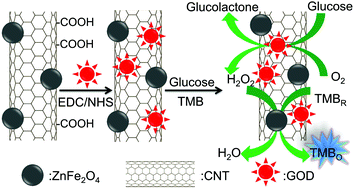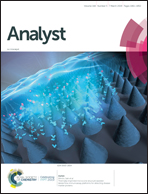Colorimetric method for glucose detection with enhanced signal intensity using ZnFe2O4–carbon nanotube–glucose oxidase composite material†
Abstract
In this paper, a composite material comprised of ZnFe2O4 nanomaterial, carbon nanotubes (CNT) and glucose oxidase (GOD) was synthesized and used for glucose detection. ZnFe2O4–CNT was formed by a one-step solvothermal approach using acid-treated CNT as precursor, then GOD was linked to it by coupling reaction between –NH2 and –COOH. After addition of glucose, which is oxidized by GOD, the intermediate product (H2O2) further oxidizes the 3,3′,5,5′-tetramethylbenzidine (TMB) substrate and forms a blue product. This process was accelerated in the presence of peroxidase-mimic ZnFe2O4 nanomaterial and the detected signal intensity was correspondingly enhanced. The linear detection range of glucose was 0.8 to 250 μM, with a limit of detection of 0.58 μM. This may originate from (1) the limited diffusion of intermediate species, which resulted in enhanced local concentrations of reaction compounds; (2) enhanced electron transmission among CNT, GOD and ZnFe2O4; (3) the synergistic enhancement of catalytic activity of ZnFe2O4 compared with other metal oxides; (4) the high loading capacity of ZnFe2O4–CNT for GOD molecules, because of its high surface-to-volume ratio. Meanwhile, this method has reasonable selectivity, stability and reusability and can be used for real serum detection, which may be useful for the development of sensitive biosensors.

- This article is part of the themed collection: Bioanalytical Sensors


 Please wait while we load your content...
Please wait while we load your content...